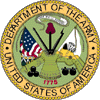| |
Regarding
the dependent variable, recognition 1, the results show one’s
rank influences how readers rate the amount and quality of stories
in the Take Off that recognize base people. The beta is strong,
positive and statistically significant, ? = .462, p = .047. With
respect to the second recognition variable, the data suggest base
newspaper use impacts the extent to which people think the paper
provides sufficient information on personal recognition and institutional
awards. The data ? = .263, p = .065 reveal a nearly significant
finding, suggesting that base paper use – not socio-demographics
– predicts recognition. Comparing the two findings, the
beta is stronger for the first variable and more statistically
significant. This means that the impact of the rank of respondents
on how they perceive the amount and quality of stories in the
paper that recognize base people is greater than the impact of
base newspaper use on whether people think the paper provides
sufficient information on personal recognition and institutional
awards.
With respect to the second dependent variable, base information,
the results demonstrate no clear correlation within the acceptable
significance level between any independent variable and the extent
to which people thought the newspaper provides information about
the base. In a similar fashion, the data indicates no clear relationship
between the independent variables and the extent to which people
perceive information about the Air Force. Finally, results show
no affects for the independent variables on how people perceive
the quality and amount of photographs and graphic illustrations
in the paper. The absence of an effect for base newspaper use
on these variables is disappointing. Apparently, base paper use
has no effect on information – about the base or the USAF.
On the other hand, the results demonstrate a high correlation
between how often people read the paper and the extent to which
they perceive the paper provides mission-essential information
to members of the command, ? = .359, p = .011. The finding is
significant and important. The paper facilitates reception of
mission-essential information.
Regarding the quality of life variable, the research indicates
a high correlation within established significance levels between
base newspaper use and the extent to which they perceive the paper
provides sufficient information to improve quality of life, ?
= .333, p = .023. Base newspaper use, and no socio-demographic
variable, contributes to perceptions of quality of life.
Regarding the cohesion variable, the data suggest that two independent
variables have an impact on the extent to which people believe
the paper promotes command cohesiveness. They are length of time
one has been working at Tinker, ? = .300, p = .020, and base newspaper
use, ? = .287, p = .028. Thus, the correlations and significance
levels are roughly equal. Both variables contribute equally to
perceptions of cohesion.
Finally, examining the personnel variable, the research suggests
a positive correlation between the length of time one has been
working at Tinker and to what extent people perceive the paper
provides sufficient information on personnel-related issues, ?
= .305, p = .035. Base newspaper use did not affect this outcome.
The Tinker Take Off meets four key objectives of military newspapers.
Base newspaper use influences how people perceive the paper provides
sufficient information on personal recognition and institutional
awards, mission-essential information to members of the command,
sufficient information to improve quality of life and promotes
command cohesiveness. This implies the more people read the paper,
the more they feel the paper provides useful information of interest
to them.
Socio-demographic features also play a role. Rank influences how
readers rate the amount and quality of stories in the base paper
that recognize base people, and length of time people have been
working on base affects whether they perceive the paper promotes
command cohesiveness and whether they think the paper provides
sufficient information on personnel-related issues. One could
speculate, the higher the rank, the more people become aware of
the base paper as promoting the interests of the command in recognizing
its troops, and the longer people have been working on the base,
the more they realize the importance of command cohesion and paying
attention to personnel-related issues.
On the other hand, the data revealed that the Tinker Take Off
did not meet three objectives of military newspapers. The data
showed none of the independent variables, including base newspaper
use and socio-demographic factors, influence how people perceive
the quality and amount of photographs in the paper and whether
they think it provides sufficient information on the base and
the Air Force. In other words, base newspaper use does not contribute
to meeting these three objectives of military newspapers. One
could speculate as to the reason why none of the independent variables
influence these three dependent measures. Perhaps, people do not
think the base newspaper presents stories about the base, the
Air Force and photographs in an appealing, effective way.
Future research should examine why certain independent variables
influence and why others do not have an impact. Additional research
should provide recommendations about what a base should do so
that its command newspaper might facilitate its objectives better.
New data will reveal whether the base should implement minor changes
or a major overhaul.
Toward a New Survey Design
The survey distributed by Tinker did not arrange the questions
by objective, not did it follow a logical sequence. In addition,
it implemented different scaling with various questions having
three to five point scales. This made it difficult to measure
for the military’s objectives regarding its newspapers.
Most importantly, the public affairs office did not have the benefit
of prior research conducted on communication scales.
Regarding media use, Chaffee & Schleuder in Moy & Pfau
(2000) distributed many surveys to measure “people’s
exposure to and attention paid to” various types of media,
including newspapers. They posited that exposure alone does not
portray accurately the extent to which people use media. For example,
the fact that people watch television does not mean they pay attention
to it. Chafee & Schleuder developed a 10-point scale for their
survey questions, ranging from “rarely use” to “frequently
use” for the exposure scale and from “little attention”
to “close attention” for attention (p. 65).
In the new survey design, the public affairs office could include
the following two questions. For exposure, the question is to
what extent do you use the base newspaper as a source for information
on _______? To assess the level of attention, the question becomes
how much attention do you pay to the base newspaper as a source
of information on _____? Researchers could list each of the military
newspaper objectives separately to fill in the blanks.
Another approach measures public perception of institutions. Moy
and Pfau (2000) state various measures to gauge the public’s
perceptions. They are the following: bad/good, unfavorable/favorable,
negative/positive, wrong/right, foolish/wise and unacceptable/acceptable
(p. 63). Thus, the survey question to measure readers’ perceptions
of the base newspaper could read: Your evaluation of the base
paper as a source of information about _______?
Bad 1 2 3 4 5 6 7 Good
Unfavorable 1 2 3 4 5 6 7 Favorable
Negative 1 2 3 4 5 6 7 Positive
Wrong 1 2 3 4 5 6 7 Right
Foolish 1 2 3 4 5 6 7 Wise
Unacceptable 1 2 3 4 5 6 7 Acceptable
|



